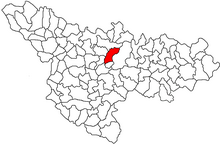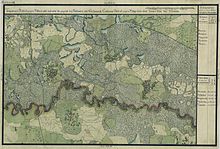Bucovăț (Timiș)
|
Bucovăț Bukowatz Bükkfalva |
||||
|
||||
| Basic data | ||||
|---|---|---|---|---|
| State : |
|
|||
| Historical region : | Banat | |||
| Circle : | Timiș | |||
| Coordinates : | 45 ° 45 ' N , 21 ° 23' E | |||
| Time zone : | EET ( UTC +2) | |||
| Area : | 33.53 km² | |||
| Residents : | 1,058 (2013) | |||
| Population density : | 32 inhabitants per km² | |||
| Postal code : | 307352 | |||
| Telephone code : | (+40) 02 56 | |||
| License plate : | TM | |||
| Structure and administration (as of 2016) | ||||
| Community type : | local community | |||
| Structure : | Bucovăț, Bazoșu Nou | |||
| Mayor : | Tiberiu Ionel Jivan ( PNL ) | |||
| Website : | ||||
Bucovăț (German: Bukowatz , Hungarian: Bükkfalva ) is a municipality in Timiș County , in the Banat region , in southwest Romania . The village of Bazoșu Nou also belongs to the municipality of Bucovăț .
Geographical location
Bucovăț is located in the center of Timiș County, 10 kilometers east of Timișoara .
Neighboring places
| Giarmata-Vii | Remetea Mare | Recaș |
| Ghiroda |

|
Bazoșu Nou |
| Moșnița Veche | Albina | Dragșina |
history
The place was first mentioned in a document in 1492. In the 17th century the village was called Beca . At the time of the Josephine land survey of 1717, Bucova was registered. After the Peace of Passarowitz (1718), when the Banat became a Habsburg crown domain , Bucova was part of the Temescher Banat . In 1723 farmers from Oltenia settled in Bucova. In 1776 the place had 82 houses.
After the Austro-Hungarian Compromise (1867), the Banat was annexed to the Kingdom of Hungary within the dual monarchy of Austria-Hungary .
At the beginning of the 20th century, the law for the Magyarization of place names (Ga. 4/1898) was applied. The official place name was Bükkfalva . The Hungarian place names remained valid in the Kingdom of Romania until the administrative reform of 1923 when the Romanian place names were introduced.
On June 4, 1920, the Banat was divided into three parts as a result of the Treaty of Trianon . The largest, eastern part, to which Bucova also belongs, fell to the Kingdom of Romania . The place received the official name Bucovăț .
Until 2007 Bucovăț belonged to the municipality of Remetea Mare . Bucovăț has been an independent municipality since 2007, and the village of Bazoșu Nou also belongs to the administrative area.
Demographics
The population development of the municipality of Bucovăț:
| census | Ethnicity | |||||||
|---|---|---|---|---|---|---|---|---|
| year | Residents | Romanians | Hungary | German | Other | |||
| 1880 | 720 | 697 | 2 | 6th | 15th | |||
| 1910 | 787 | 774 | - | - | 13 | |||
| 1930 | 774 | 769 | - | - | 5 | |||
| 1977 | 647 | 647 | - | - | - | |||
| 2002 | 582 | 582 | - | - | - | |||
Web links
- cjtimis.ro , Bucovăț on the Timiș County Council website
- ghidulprimariilor.ro , Bucovăț Citizens' Registration Office
Individual evidence
- ↑ Mayoral elections 2016 in Romania ( MS Excel ; 256 kB)
- ^ Gerhard Seewann : History of the Germans in Hungary , Volume 2 1860 to 2006, Herder Institute, Marburg 2012
- ↑ kia.hu , (PDF; 982 kB) E. Varga: Statistics of the number of inhabitants by ethnic group in the Timiș district according to censuses from 1880 - 2002




